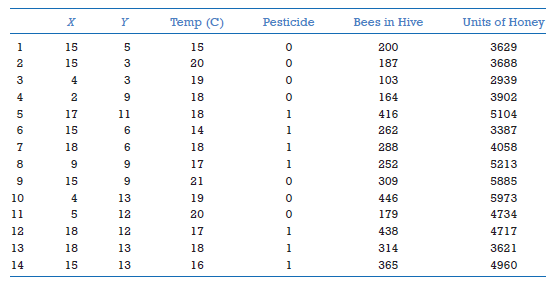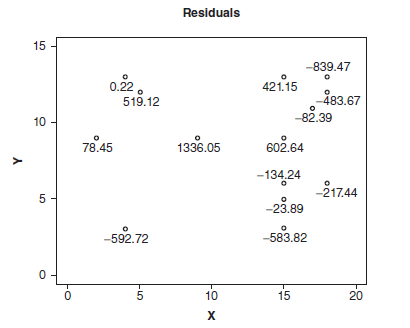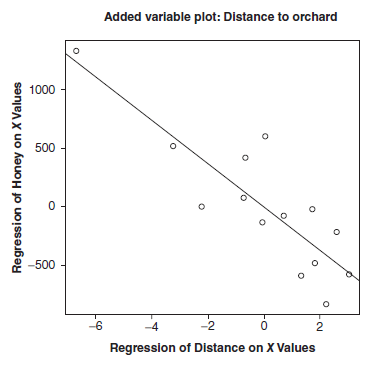A beekeeper society is interested in the production of honey in a region, and have theorized that honey production is a function of the number of bees in a hive, whether the farms near the hive use pesticides, and the local temperature. Perform an ordinary least squares regression on the following data, with honey production being the dependent variable, and plot the residuals in space. Do they show signs of autocorrelation? Use an added variable plot to determine whether they should also include the distance between the hives and a local orchard located at (8,10) in their regression. Run the regression again with the new variable and compare the r2 values and standard errors.

The regression equation associated with the data is given by

Of these, only the number of bees appears to be significant to the equation, which has a relatively low r2 value of .629 with a standard error of 656.1. The pattern of the residuals does suggest autocorrelation:

Thus we calculate the distance between each of the locations and the orchard and regress this variable on the x values. We compare the two sets of residuals and produce the following added variable plot:

There is a distinct linear trend, which leads us to suspect that we should include the variable in our regression. Doing so, we find the next regression equation:

The r2 value is much higher at .9, and the standard error is 358.3, which is much lower.
You might also like to view...
In developing countries, demographic transition is least likely to be hindered by ____.
A. environmental degradation B. extreme poverty C. resource depletion D. a drop in economic assistance from developed countries E. an increase in education opportunities for women
Most of the world population growth in the near future will be in ________
A) North America B) Europe C) developed countries D) currently uninhabited areas such as Antarctica E) developing countries
Critical evidence for the Cretaceous-Tertiary boundary impact includes ________.
A. the discovery of a crater covered by jungle vegetation in Brazil B. an iridium anomaly in a thin layer of rock 65 million years old C. dinosaur fossils worldwide just above the layer of impact debris D. recovery of very large pieces of meteorite E. an Iranian deposit of reddish iron-bearing strata
The oldest ocean crust is located ________.
A. on top of oceanic hot spots B. next to continental margins C. in the middle of ocean basins D. along mid-ocean ridges